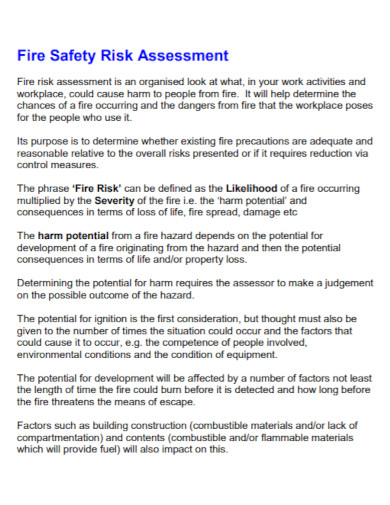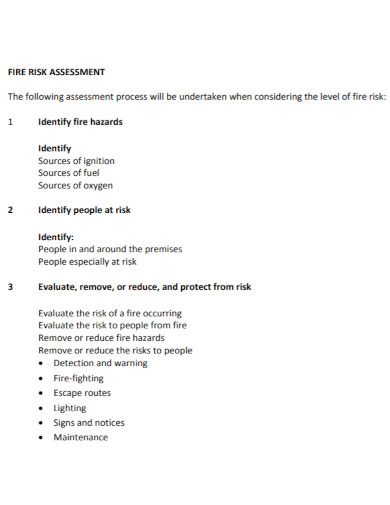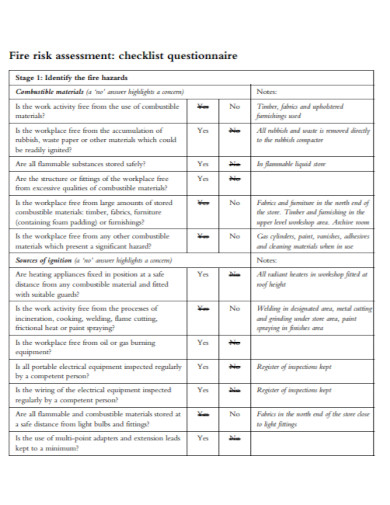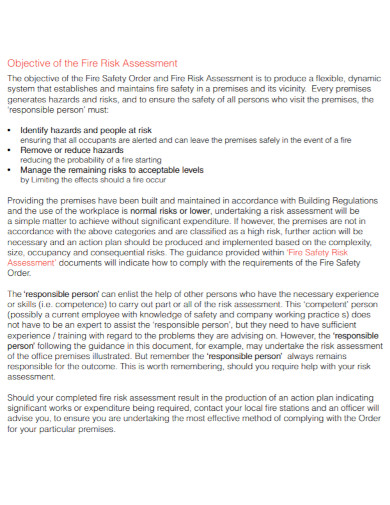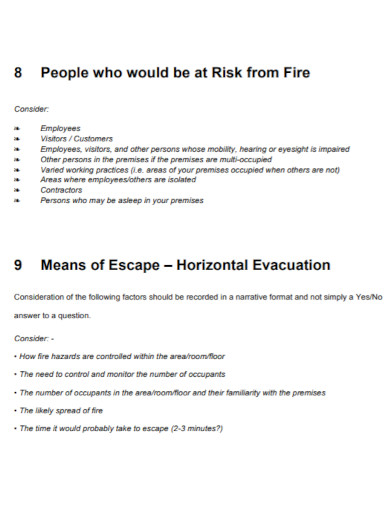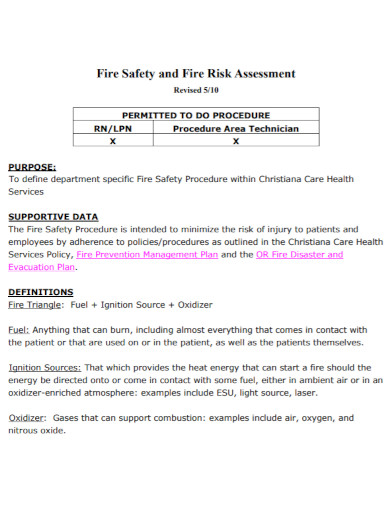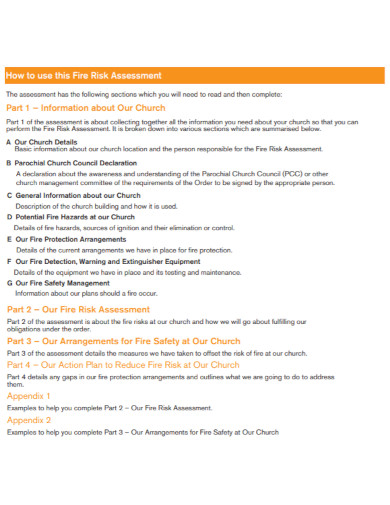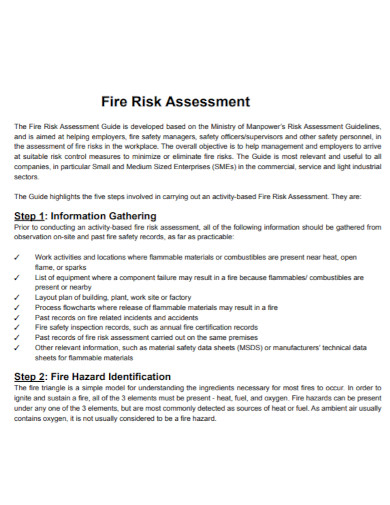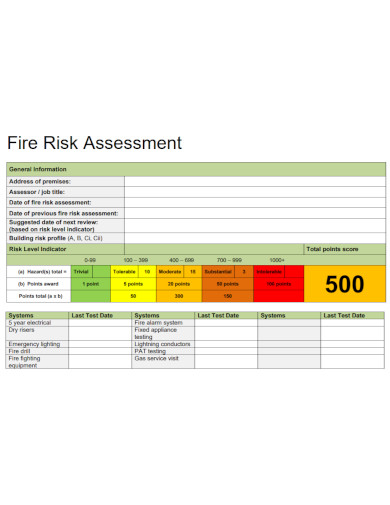10+ Fire Risk Assessment Examples to Download
It is without a doubt that the safety of everyone present should be the top priority especially when there are occurrences that we may not expect. One of which would be fire. Fires can start just about anywhere and anytime. It can affect just about anyone young and old. The best thing to do is to find a way to stop this incident before it has the chance to happen, or if it already happened, to stop before it gets worse. This is why doing a risk assessment of the place first before having to stay or use it is always the best option. To avoid risks that could cost a person’s life. For more information about what a fire risk assessment can do, what it is for and how to do one, check it all out below now.
10+ Fire Risk Assessment Examples
1. Fire Risk Assessment Template
2. Fire Safety Risk Assessment
3. General Fire Risk Assessment
4. Standard Fire Risk Assessment
5. Formal Fire Risk Assessment
6. Fire Risk Assessment Report
7. Fire Risk Assessment in PDF
8. Basic Fire Risk Assessment
9. Church Fire Risk Assessment
10. Draft Fire Risk Assessment
11. Printable Fire Risk Assessment
What Is a Fire Risk Assessment?
A fire risk assessment is a kind of risk assessment that serves as a way to know how severe the place may be for any fire related issues. It is also a kind of assessment that gives out information about the building being assessed. A fire risk assessment is a kind of assessment that gives a careful and cautious look at the place for any risk that it may present. In this case, the fire. It also looks closely at the people who may be using the building, if they are at risk of any fire accident. If they believe the risks are too high, they will place an assessment, analyze if there is any way to avoid the risk and to evaluate before giving out the final result. A fire risk assessment also assesses any potential risks that could trigger and find ways to improve on the safety of everyone present.
The purpose of having to do a fire risk assessment is to find out about the risks and hazards that may be present inside the building or the location. It also looks for ways that could either prevent or worsen the issue. Since safety is the top priority when it comes to having the risk assessment done, the person assigned to do the assessment must find a way to resolve this issue to make the place livable as much as possible. All this would be possible if the assessment result comes out as a good result.
How to Write a Fire Risk Assessment?
Now, you may be wondering what the difference of this risk assessment is to the other kinds of risk assessments. The only difference is this is for fire. For those who may have gone through writing a risk assessment would know that there are some things to consider. Don’t worry for those who have not as this article will show you how. Check out the following tips to consider when you are planning on doing a fire risk assessment.
1. Observe the Location
Before you begin with the risk assessment, the first thing that should be done is to observe the said location. Include the outer part of the location. As most often would exclude it, but the outer part of the location still holds enough risk and hazards like the location inside. Observe both and take down some notes.
2. Gather All the Data
Gathering all the data included taking down notes. The reason why this step is important is because the data that has been gathered would be used for the assessment later on. Your data does not have to be a lot as long as the main or the key points are there to be used for your assessment. Unwanted data would be more likely to be deleted than to be added in the assessment.
3. Rate the Risk
There are some ways to know if the risk and the hazards of this location is high, mild or low. Doing a rating on the risk would immediately tell you that this place can or cannot be used or is safe or not. Telling the people staying in the location would be a bit of a challenge if you do not provide the evidence of the risk and its rating.
4. Assess, Analyze, Evaluate
While doing the activity, do not forget to assess, to analyze and to give the evaluation of the assessment. The results matter a lot as this is a good way of seeing if the location or the place holds a higher or a lower chance of any fire risks.
5. Make an Action Plan
Make an action plan that would match the severity of the situation. The action plan should also be complete with the solutions, the objectives and the realistic results.
FAQs
Why is a fire risk assessment useful?
A fire risk assessment helps out by assessing the location if it is safe enough to be of use, or if it is too dangerous.
Is there another way to know if the severity of the location is worse?
A fire risk assessment does that type of work for you. It assesses the problem, finds a solution and gives out the level of severity as well.
Can a fire risk assessment result be wrong?
The only time it would be wrong is if in the middle of the assessment, something went wrong.
It goes without saying, fires can be a dangerous hazard at any time and anywhere. It not only destroys places but can also cause harm to others. The reason for having to do a fire risk assessment is to eliminate the potential problems that may cause unwanted fires. For that, if the assessment is done right, it gives out the level of severity, the solutions to the problem and it also keeps every single person safe.


![10+ Fire Risk Assessment Examples [ Safety, Church, College ]](https://images.examples.com/wp-content/uploads/2021/08/10-Fire-Risk-Assessment-Examples-Safety-Church-College-.jpg)

